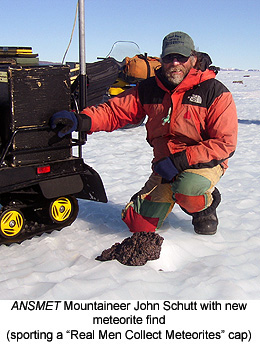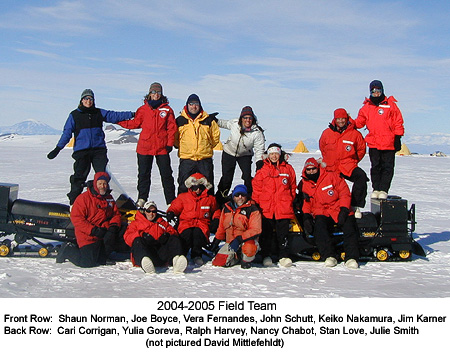Kevin Righter, NASA-JSC New Meteorites
This newsletter contains classifications for 448 new meteorites from the 2002 and 2003 ANSMET collections. They include samples from the LaPaz Ice Field, MacAlpine Hills, Pecora Escarpment, Queen Alexandra Range, Dominion Range, Miller Range, Roberts Massif, and Sanford Cliffs. Petrographic descriptions are given for 30 of the new meteorites; 2 howardites, 2 diogenites, 1 brecciated eucrite, 1 ureilite, 3 CK and 10 CM chondrites, 6 type 3 ordinary chondrites, a metal-rich chondrite (similar to QUE 94411), an EL4, an R chondrite, and an ungrouped iron. Several of these new meteorites are paired with samples from previous newsletters (see Table 3). However, the three new CK chondrites bring the number of US Antarctic CK's to a total of 75 (20 unique meteorites with pairings). The large numbers and diversity of meteorites in the last several years (2002 = 924; 2003 = 1356; 2004 = 1230) is undoubtedly due to having two teams searching in separate areas for the ANSMET field season.
US Antarctic Meteorite Program
The US Antarctic Meteorite program (NSF-Smithsonian-NASA) is thriving and more active than ever. Last September, the Meteorite Working Group met in Arlington, Virginia to assess 107 individual requests for US Antarctic Meteorites. After MWG recommendations and Meteorite Steering Group (MSG) approval, the Meteorite Processing and Thin Section Laboratories allocated a total of 570 samples to 82 investigators. This is a new record for the US program, as previously the highest numbers of requests were 60 in Fall 1982 (following announcement of a new lunar meteorite ALHA81005) and 74 in Spring 1997 (after announcing the presence of possible fossil life in ALH 84001). The record number of requests this past Fall was due to the announcement of a new nakhlite and also the great diversity of new chondrites and achondrites announced in the Fall newsletter. The enormous number of approved requests increased the processing time to complete all the allocations, and we thank everyone for being patient during this record breaking time.
Lunar Meteorite Compendium
Work is continuing on a Lunar Meteorite Compendium. Draft chapters have been completed for the three largest and most extensively studied US Antarctic meteorites - ALHA81005 (the first recognized lunar meteorite), MAC 88105 and LAP 02205 (and their pairings). Processing sketches and genealogy charts have been prepared for these meteorites, and will soon be posted on our website. In addition, chapters are underway for the other lunar meteorites in our collections - QUE 93069/94269, QUE 94281, EET 87521/96008, MET 01210 and PCA 02007. Ultimately the compendium will include all 32 known lunar meteorites, but we have started with those in our collection. In the meantime if you have some lunar meteorite publications that you think may be relevant to such a project, please send them to kevin.righter-1@nasa.gov. A few of you have done this already, and it has been very beneficial - thank you!
Processing of the New Nakhlite - MIL 03346
In July 2004, we announced the availability of a new 715 gram nakhlite, MIL 03346 - the seventh nakhlite recognized in world collections, the third nakhlite returned from Antarctica, and the first nakhlite in the US Antarctic collection. We received 49 requests for material from scientists from 8 countries. MWG and MSG proposed that 47 requests be honored which included preparation and allocation of 90 individual sample splits. Due to the large number of individual samples requested, slabbing was considered the best way to preserve as much of the original mass as possible for future study and also to document the individual meteorite chips allocated. A 1 cm thick slab was made of MIL03346 (see photo) and all of the chips and potted butts for thin sections were obtained from the slab. The multitude of analytical techniques used today requires the use of many different kinds of sections - we prepared close to 40 thick and thin sections of various types. Finally, several investigators requested spatially documented samples that are critical to the scientific problems being addressed. All samples were supported with photo-documentation during preparation and processing of those splits.

Ralph Harvey, Principal Investigator
Antarctic Search for Meteorites (ANSMET) program
By the time you read this, the 2004-2005 ANSMET season, our 28th, will have been officially over for a couple of weeks now. I'm happy to report yet another successful trip, by all the important measures.  To whit, we found a lot of interesting meteorites, explored a lot of blue ice, ate a lot of chocolate, froze a lot of fingers, scratched a lot of goggles, melted a lot of ice, exploded a lot of stoves, broke a lot of snowmobiles, got blown around by a lot of wind, waited for a lot for airplanes, and most important of all, nobody was seriously injured either physically or mentally - at least that they'll admit.
To whit, we found a lot of interesting meteorites, explored a lot of blue ice, ate a lot of chocolate, froze a lot of fingers, scratched a lot of goggles, melted a lot of ice, exploded a lot of stoves, broke a lot of snowmobiles, got blown around by a lot of wind, waited for a lot for airplanes, and most important of all, nobody was seriously injured either physically or mentally - at least that they'll admit.
The systematic searching team was once again at the LaPaz icefields, where significant regions of promise remained unsearched. LaPaz is a really big place, where concentrations can vary many fold over a few kilometers, and this year we were in an area where density of finds was lower than last year, but still worth our time to systematically search. In spite of typical (read: windy) LaPaz weather, we managed to search all but the smallest corners of our targeted region, affectionately and informally known as "Pebble Beach". The total yield was 417 new meteorite specimens, including both interesting new finds and new larger pieces of cool stuff found during previous seasons.
The reconnaissance team had some significant ground to cover as well; their goal was to explore several previously unvisited icefields that lie along the Transantarctic Mountains between the Shackleton and Beardmore Glaciers. Given that their efforts are directed at discovery and exploration rather than systematic meteorite recovery, you might expect their totals to be lower on average. But this year was not average - the reconnaissance team recovered 813 specimens, probably amounting to 300 kg or more in mass. These finds represent a variety of discoveries; at least one icefield worth a significant future visit, and an end-of-season effort to finish recoveries at the MacAlpine Hills icefields. These finds are all the more amazing given the many aircraft and weather delays the recon team experienced - with good weather, who knows what they would have found.
In summary, the 2004-2005 seasons yielded 1230 meteorites from a variety of sites both new and old, with a total mass something like 400 kg. That's a big burden on the preliminary characterization and classification folks, so we're all waiting patiently to see what new meteoritic gems might be in the bag.

Finally, I'd like to inform you of a few other events of note.
- Many of you have attended or participated in our ANSMET slide show held annually at the Lunar and Planetary Science Conference, when recently returned ANSMET volunteers show their best slides and spin a few stories about the previous season. This year's slideshow will be held Wednesday night in the Amphitheater of the South Shore Harbour (time to be announced at the meeting). If you're an ANSMET veteran, it's a great way to relive the past; and if you're someone interested in joining us in the field someday, it's a great way to learn more about ANSMET so you can talk yourself out of it. Please join us!
- For the last three and a half years Nancy Chabot has been ANSMET's second officer, helping to lead both field parties and ensure successful seasons. As of this spring, she's moving on to a great new position at the Applied Physics Laboratory at Johns Hopkins University. Please join me in wishing her all the possible luck in her new job and thanking her for the generous service she has given ANSMET, which includes, among many other things, living in a tent on the polar plateau for 200+ days.
And note, if the recon team does get resurrected (see below), I'll be in the market for someone to fill Nancy's bunny boots as a second science lead for ANSMET. If you know of anyone in the market for an, ahem, "invigorating" postdoctoral opportunity, don't hesitate to have them contact me. - Readers of this newsletter should be made aware of some uncertainty concerning the possible deployment of the reconnaissance team next season. NSF support for next year's systematic searching team is solid. However, with a little more than 8 months to go, funding and interagency agreements required for deployment of the NASA-supported recon team are not in place. The recon team has provided an amazing bounty of new discoveries, but it's always been difficult to support, and I want the community to have realistic expectations should the deployment not occur.